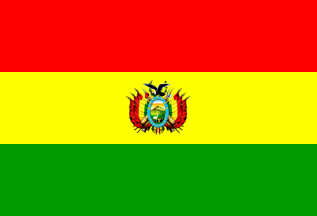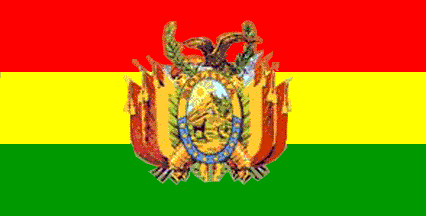TYPE: National flag.
USAGE:
RATIO: 15:22
ADOPTED: 31 October 1851
STATE FLAG:
NAVAL ENSIGN:

Last modified: 2016-04-30 by alex garofolo
Keywords: bolivia | buliwya | wuliwya | volívia | state flag | variation | fertility | bravery | wealth | president | flag: national | disc (blue) |
Links: FOTW homepage |
search |
disclaimer and copyright |
write us |
mirrors

TYPE: National flag.
USAGE:(Officially, for civilian use at land and sea.)
RATIO: 15:22
ADOPTED: 31 October 1851
STATE FLAG:
NAVAL ENSIGN:
The Bolivian tricolour was first hoisted in 1851 and is tierced in fess red, yellow, green. The colours are said to represent patriotic bloodshed, hope, and nature's bounty. An older interpretation sees the red as patriotic bloodshed and yellow as the nation's mineral wealth.
A presidential decree of 14 July 1888 defined the Coat of Arms (Article I), Great Seal of the State (Art. III), the National Flag (Art. V), the 1888 Flag (Art. VI), the State Flag (Art. VII) and the customs of their usage. In its preamble, it mentioned «keeping in mind the laws of 17 August 1825, 26 July 1826 and 5 September 1851» which had prescribed, not just the look of the symbols, but the customs of their usage. The most recent law on national symbols was published on 19 July 2004, in a special edition of the Gaceta Oficial de Bolivia 2630/XLIV.
The current flag is a rearrangement of the previous flag, used from 25 July 1826 to 1851, which was yellow over red over green. There is speculation, but no definitive proof, that the 1826-1851 flag was based directly on the Bandera Madre, from which the flags of neighbouring Colombia, Venezuela (and later Ecuador) evolved.
During colonial times, Bolivia was known as Alta Perú (Upper Peru) and was always under the rule of the Virreinato de Perú, the major loyalist stronghold. In 1825, Alta Perú was the last part of South America to be liberated from Spain, and was named in honour of Simón Bolívar. The first Bolivian flag was adopted on 17 August 1825, and was based on the Spanish flag with the broad fess, but in the colours green-red-green; it lasted for less than one year. The second flag was adopted on 25 July 1826 and was used until 1838, then again from 1839 until 1851. During the 1838-9 union with Peru, the Confederación Perú-boliviana used a red flag with some design attributes in common with the 1825 Bolivian flag.
The Ethiopian tricolour was adopted in 1936 (based on flags used from 1897 onwards). It became sort of the Bandera Madre of Subsaharan Africa during the continental liberation of the 1960s onward, with 15 nations adopting the exact colour scheme in solidarity. It's most likely a coincidence that the colour scheme and symbolism are the same on the Ethiopian and Bolivian flags (minus charges), but it is interesting to note that the representation of natural resources (agricultural and mineral) and historical bloodshed is extremely common in Subsaharan African flags and less so in Latin American ones.
Bolivia is the only Latin American nation whose flag has always had both a civil version (without arms) and an institutional version (with arms). This practice was introduced to the Americas by the Spanish from 1785 onwards. Many nations have adopted the practice during their history, all of them are found in Latin America and Western/Central Europe.
The original naval ensign was adopted in 1841 as fesswise blue, red, yellow. While this ensign was in use, Bolivia lost its littoral province and 510 km Pacific coastline to Chile in the 1888 of the Pacific. During the first half of the 19th century, this former naval ensign was revived as the flag in-exile of the Litoral de Antofagasta — the region of northern Chile that is still claimed by Bolivia. In 1966, the current naval ensign was adopted following the canton pattern of British ensigns and it is used in parades and by ships that patrol rivers and lakes.
Alex Garofolo, 20 Jan 2015.
The Bolivian flag is a vertical tricolour (tierced in fess) of red, yellow and green, as defined by Article V of the 1888 Decree.
Article III of the 2004 flag law gives the official pantone color shades: red is PMS 485 CVU, yellow is PMS Process Yellow, and green is PMS 356 CVU. Red and yellow match both the images on these pages and the illustrations in the law, but the shade of green not so: While the prescribed PMS value is darker than regular green (![]() ), the law text illustrations show a much brighter shade.
), the law text illustrations show a much brighter shade.
The national flag, according to Article II of the 2004 flag law, has a ratio of 7.5:11, which is 15:22 in vexillological terms. No mention was made of its ratio in the 1888 decree.
The state flag, according to Article VII of the 1888 decree, has a ratio of «6 metres in length by 4 in width» or 2:3 in vexillological terms.
Article I of the 2004 flag law explains the colours as patriotic bloodshed, hope and nature's bounty. In Whitney Smith’s Flags through he Ages and Across the World [smi75b] the red is said to stand for the bravery of the Bolivian soldier, yellow represents the country’s mineral resources and green is the fertility of the land. Webster’s Concise Encyclopedia of Flags, 1985 [mch85a] defines them as the gallantry of Bolivian soldiers, the country’s mineral wealth, and the fertility of the land.
Jaume Ollé, 01 Jan 1996; Stephan Hurford, 13 Feb 2000; Jarig Bakker, 13 Feb 2000; Željko Heimer, 11 Mar 2001; António Martins-Tuválkin, 19 Aug 2005; Christopher Southworth, 09 Apr 2006; & Alex Garofolo, 21 Jan 2015.

TYPE: State flag.
USAGE:(Officially, for use on government buildings & boats)
RATIO: 15:22
ADOPTED: 31 October 1851
CONFIRMED: 14 July 1888 & 19 July 2004
In the 1888 decree, Articles VI thru VII deal with the War Flag (Art. VI), the State Flag (Art.VII) and regulations concerning flag usage.
The note beside the state flag in the Album 2000 [pay00] describes that it is also the personal flag for the President of the Republic and and that it is also used in 1:2 variant. FOTW contributer Mark Sensen was in Bolivia from 2001 to 2005, reported that "the state flag is hardly ever seen. Even over the presidential palace the plain tricolour is flown."
Conducting an image search on the internet is not a method for obtaining definitive evidence, but it can yield some telling results. Searching bolivia+palacio presidencial brings up pictures of the presidential palace flying the plain tricolour. Searching bolivia+presidente yields pictures of the state flag, with arms, being used indoors, with the President present. This would suggest that the State Flag has become more of a Presidential Flag.
Željko Heimer, 11 Mar 2001; Mark Sensen, 03 Jul 2005; & Alex Garofolo, 23 Jan 2015.

FIS:
According to an original piece received from the Bolivian Embassy in Paris (and a phone call from them), the flag should normally be in 2:3 ratio, the flag in 1:2 is a variant. My sources have various sizes of coat of arms on the flag.
Armand du Payrat, 28 Sep 1999, 12 Mar 2001.
.gif)
FIS:
Flags and Arms across the World, by Whitney Smith [smi80], shows the coat of arms set in light blue disk of diameter equal to yellow stripe height. According to the Bolivian Embassy in Paris and the French Embassy in La Paz, the arms are not set on a blue disc.
Article I of the 1888 decree describes the Coat of Arms. The final sentence is «El campo exterior será azul perlado» or «The exterior field shall be pearl blue». In the 2004 decree, Chapter II, covers the National Coat of Arms and Article 5 is basically the same as the opening article in the 1888 decree. But the 2004 decree clarifies that «Cuando corresponda, el campo exterior al Escudo será azul perlado» or «When appropriate, the exterior field shall be pearl blue».
Željko Heimer, 11 Mar 2001; Armand du Payrat, 12 Mar 2001; António Martins-Tuválkin, 19 Aug 2005; & Alex Garofolo, 23 Jan 2015.
The presidential decree of 7 August 1825 described the 1825 Coat of Arms. The current flag was promulgated by the decree of President Manuel Belzu in late 1851. The decree of 14 July 1888 described the Coat of Arms, and the flags for civil, state and military use. The 2004 decree described the same symbols as the 1888 document, but offered very detailed descriptions.
The full text of each decree can be read, in Spanish, on external links provided in the menu of this page.
Anything below this line was not added by the editor of this page.